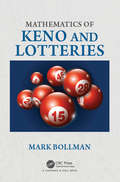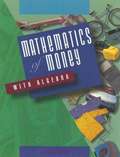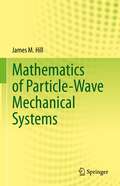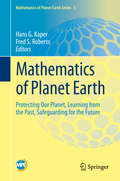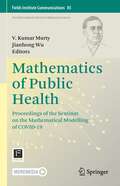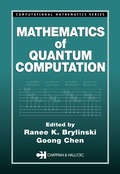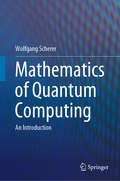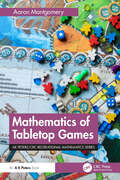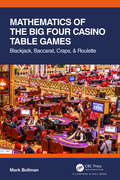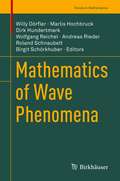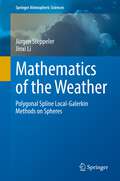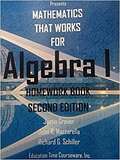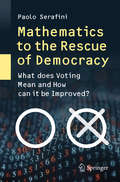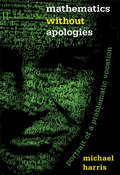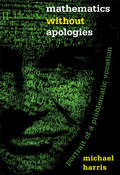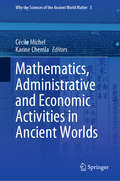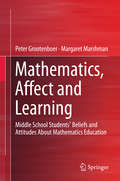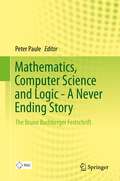- Table View
- List View
Mathematics of Investment and Credit
by Samuel A. BrovermanInterest rate measurement -- Valuation of annuities -- Loan repayment -- Bond valuation -- Measuring the rate of return of an investment -- The term structure of interest rates -- Cashflow duration and immunization -- Additional topics in finance and investment -- Forwards, futures, swaps, and options -- Answers to selected exercises -- Bibliography -- Index
Mathematics of Keno and Lotteries (AK Peters/CRC Recreational Mathematics Series)
by Mark BollmanMathematics of Keno and Lotteries is an elementary treatment of the mathematics, primarily probability and simple combinatorics, involved in lotteries and keno. Keno has a long history as a high-advantage, high-payoff casino game, and state lottery games such as Powerball are mathematically similar. MKL also considers such lottery games as passive tickets, daily number drawings, and specialized games offered around the world. In addition, there is a section on financial mathematics that explains the connection between lump-sum lottery prizes (as with Powerball) and their multi-year annuity options. So-called "winning systems" for keno and lotteries are examined mathematically and their flaws identified.
Mathematics of Machine Learning: Master linear algebra, calculus, and probability for machine learning
by Tivadar DankaBuild a solid foundation in the core math behind machine learning algorithms with this comprehensive guide to linear algebra, calculus, and probability, explained through practical Python examples Purchase of the print or Kindle book includes a free PDF eBook Key FeaturesMaster linear algebra, calculus, and probability theory for MLBridge the gap between theory and real-world applicationsLearn Python implementations of core mathematical conceptsBook DescriptionMathematics of Machine Learning provides a rigorous yet accessible introduction to the mathematical underpinnings of machine learning, designed for engineers, developers, and data scientists ready to elevate their technical expertise. With this book, you’ll explore the core disciplines of linear algebra, calculus, and probability theory essential for mastering advanced machine learning concepts. PhD mathematician turned ML engineer Tivadar Danka—known for his intuitive teaching style that has attracted 100k+ followers—guides you through complex concepts with clarity, providing the structured guidance you need to deepen your theoretical knowledge and enhance your ability to solve complex machine learning problems. Balancing theory with application, this book offers clear explanations of mathematical constructs and their direct relevance to machine learning tasks. Through practical Python examples, you’ll learn to implement and use these ideas in real-world scenarios, such as training machine learning models with gradient descent or working with vectors, matrices, and tensors. By the end of this book, you’ll have gained the confidence to engage with advanced machine learning literature and tailor algorithms to meet specific project requirements. What you will learnUnderstand core concepts of linear algebra, including matrices, eigenvalues, and decompositionsGrasp fundamental principles of calculus, including differentiation and integrationExplore advanced topics in multivariable calculus for optimization in high dimensionsMaster essential probability concepts like distributions, Bayes' theorem, and entropyBring mathematical ideas to life through Python-based implementationsWho this book is forThis book is for aspiring machine learning engineers, data scientists, software developers, and researchers who want to gain a deeper understanding of the mathematics that drives machine learning. A foundational understanding of algebra and Python, and basic familiarity with machine learning tools are recommended.
Mathematics of Money with Algebra
by Cheryl ClaytonMathematics of Money with Algebra will use and extend the skills you learned in Algebra I to help you manage your own finances
Mathematics of Particle-Wave Mechanical Systems
by James M. HillDespite successes of modern physics, the existence of dark energy and matter is indicative that conventional mechanical accounting is lacking. The most basic of all mechanical principles is Newton’s second law, and conventionally, energy is just energy whether particle or wave energy. In this monograph, Louis de Broglie’s idea of simultaneous existence of both particle and associated wave is developed, with a novel proposal to account for mass and energy through a combined particle-wave theory. Newton’s second law of motion is replaced by a fully Lorentz invariant reformulation inclusive of both particles and waves. The model springs from continuum mechanics and forms a natural extension of special relativistic mechanics. It involves the notion of “force in the direction of time” and every particle has both particle and wave energies, arising as characteristics of space and time respectively. Dark matter and energy then emerge as special or privileged states occurring for alignments of spatial forces with the force in the direction of time. Dark matter is essentially a backward wave and dark energy a forward wave, both propagating at the speed of light. The model includes special relativistic mechanics and Schrödinger’s quantum mechanics, and the major achievements of mechanics and quantum physics. Our ideas of particles and waves are not yet properly formulated, and are bound up with the speed of light as an extreme limit and particle-wave demarcation. Sub-luminal particles have an associated superluminal wave, so if sub-luminal waves have an associated superluminal particle, then there emerges the prospect for faster than light travel with all the implications for future humanity. Carefully structured over special relativity and quantum mechanics, Mathematics of Particle-Wave Mechanical Systems is not a completed story, but perhaps the first mechanical model within which such exalted notions might be realistically and soberly examined. If ultimately the distant universe become accessible, this will necessitate thinking differently about particles, waves and the role imposed by the speed of light. The text constitutes a single proposal in that direction and a depository for mathematically related results. It will appeal to researchers and students of mathematical physics, applied mathematics and engineering mechanics.
Mathematics of Planet Earth: Protecting Our Planet, Learning from the Past, Safeguarding for the Future (Mathematics of Planet Earth #5)
by Hans G. Kaper Fred S. RobertsSince its inception in 2013, Mathematics of Planet Earth (MPE) focuses on mathematical issues arising in the study of our planet. Interested in the impact of human activities on the Earth’s system, this multidisciplinary field considers the planet not only as a physical system, but also as a system supporting life, a system organized by humans, and a system at risk. The articles collected in this volume demonstrate the breadth of techniques and tools from mathematics, statistics, and operations research used in MPE. Topics include climate modeling, the spread of infectious diseases, stability of ecosystems, ecosystem services, biodiversity, infrastructure restoration after an extreme event, urban environments, food security, and food safety. Demonstrating the mathematical sciences in action, this book presents real-world challenges for the mathematical sciences, highlighting applications to issues of current concern to society. Arranged into three topical sections (Geo- and Physical Sciences; Life Sciences, Ecology and Evolution; Socio-economics and Infrastructure), thirteen chapters address questions such as how to measure biodiversity, what mathematics can say about the sixth mass extinction, how to optimize the long-term human use of natural capital, and the impact of data on infrastructure management. The book also treats the subject of infectious diseases with new examples and presents an introduction to the mathematics of food systems and food security. Each chapter functions as an introduction that can be studied independently, offering source material for graduate student seminars and self-study. The range of featured research topics provides mathematical scientists with starting points for the study of our planet and the impact of human activities. At the same time, it offers application scientists a plethora of modern mathematical tools and techniques to address the various topics in practice. Including hundreds of references to the vast literature associated with each topic, this book serves as an inspiration for further research.
Mathematics of Program Construction: 13th International Conference, MPC 2019, Porto, Portugal, October 7–9, 2019, Proceedings (Lecture Notes in Computer Science #11825)
by Graham HuttonThis book constitutes the refereed proceedings of the 13th International Conference on Mathematics of Program Construction, MPC 2019, held in Porto, Portugal, in October 2019. The 15 revised full papers presented together with an invited paper were carefully reviewed and selected from 22 submissions. The papers deal with mathematical principles and techniques for constructing computer programs. They range from algorithmics to support for program construction in programming languages and systems. Some typical areas are type systems, program analysis and transformation, programming-language semantics, security, and program logics.
Mathematics of Public Health: Mathematical Modelling from the Next Generation (Fields Institute Communications #88)
by Jianhong Wu Jummy DavidThis volume addresses SDG 3 from a mathematical standpoint, sharing novel perspectives of existing communicable disease modelling technologies of the next generation and disseminating new developments in modelling methodologies and simulation techniques. These methodologies are important for training and research in communicable diseases and can be applied to other threats to human health. The contributions contained in this collection/book cover a range of modelling techniques that have been and may be used to support decision-making on critical health related issues such as: Resource allocation Impact of climate change on communicable diseases Interaction of human behaviour change, and disease spread Disease outbreak trajectories projection Public health interventions evaluation Preparedness and mitigation of emerging and re-emerging infectious diseases outbreaks Development of vaccines and decisions around vaccine allocation and optimization The diseases and public health issues in this volume include, but are not limited to COVID-19, HIV, Influenza, antimicrobial resistance (AMR), the opioid epidemic, Lyme Disease, Zika, and Malaria. In addition, this volume compares compartmental models, agent-based models, machine learning and network. Readers have an opportunity to learn from the next generation perspective of evolving methodologies and algorithms in modelling infectious diseases, the mathematics behind them, the motivation for them, and some applications to supporting critical decisions on prevention and control of communicable diseases. This volume was compiled from the weekly seminar series organized by the Mathematics for Public Health (MfPH) Next Generation Network. This network brings together the next generation of modellers from across Canada and the world, developing the latest mathematical models, modeling methodologies, and analytical and simulation tools for communicable diseases of global public health concerns. The weekly seminar series provides a unique forum for this network and their invited guest speakers to share their perspectives on the status and future directions of mathematics of public health.
Mathematics of Public Health: Proceedings of the Seminar on the Mathematical Modelling of COVID-19 (Fields Institute Communications #85)
by Jianhong Wu V. Kumar MurtyCurated by the Fields Institute for Research in Mathematical Sciences from their COVID-19 Math Modelling Seminars, this first in a series of volumes on the mathematics of public health allows readers to access the dominant ideas and techniques being used in this area, while indicating problems for further research. This work brings together experts in mathematical modelling from across Canada and the world, presenting the latest modelling methods as they relate to the COVID-19 pandemic. A primary aim of this book is to make the content accessible so that researchers share the core methods that may be applied elsewhere. The mathematical theories and technologies in this book can be used to support decision makers on critical issues such as projecting outbreak trajectories, evaluating public health interventions for infection prevention and control, developing optimal strategies to return to a new normal, and designing vaccine candidates and informing mass immunization program. Topical coverage includes: basic susceptible-exposed-infectious-recovered (SEIR) modelling framework modified and applied to COVID-19 disease transmission dynamics; nearcasting and forecasting for needs of critical medical resources including personal protective equipment (PPE); predicting COVID-19 mortality; evaluating effectiveness of convalescent plasma treatment and the logistic implementation challenges; estimating impact of delays in contact tracing; quantifying heterogeneity in contact mixing and its evaluation with social distancing; modelling point of care diagnostics of COVID-19; and understanding non-reporting and underestimation. Further, readers will have the opportunity to learn about current modelling methodologies and technologies for emerging infectious disease outbreaks, pandemic mitigation rapid response, and the mathematics behind them. The volume will help the general audience and experts to better understand the important role that mathematics has been playing during this on-going crisis in supporting critical decision-making by governments and public health agencies.
Mathematics of Quantum Computation
by Goong Chen Ranee K. BrylinskiAmong the most exciting developments in science today is the design and construction of the quantum computer. Its realization will be the result of multidisciplinary efforts, but ultimately, it is mathematics that lies at the heart of theoretical quantum computer science.Mathematics of Quantum Computation brings together leading computer sc
Mathematics of Quantum Computation and Quantum Technology
by Goong Chen Louis Kauffman Samuel J. LomonacoResearch and development in the pioneering field of quantum computing involve just about every facet of science and engineering, including the significant areas of mathematics and physics. Based on the firm understanding that mathematics and physics are equal partners in the continuing study of quantum science, Mathematics of Quantum Computation an
Mathematics of Quantum Computing: An Introduction
by Wolfgang SchererThis textbook presents the elementary aspects of quantum computing in a mathematical form. It is intended as core or supplementary reading for physicists, mathematicians, and computer scientists taking a first course on quantum computing. It starts by introducing the basic mathematics required for quantum mechanics, and then goes on to present, in detail, the notions of quantum mechanics, entanglement, quantum gates, and quantum algorithms, of which Shor's factorisation and Grover's search algorithm are discussed extensively. In addition, the algorithms for the Abelian Hidden Subgroup and Discrete Logarithm problems are presented and the latter is used to show how the Bitcoin digital signature may be compromised. It also addresses the problem of error correction as well as giving a detailed exposition of adiabatic quantum computing. The book contains around 140 exercises for the student, covering all of the topics treated, together with an appendix of solutions.
Mathematics of Tabletop Games (AK Peters/CRC Recreational Mathematics Series)
by Aaron MontgomeryMathematics of Tabletop Games provides a bridge between mathematics and hobby tabletop gaming. Instead of focusing on games mathematicians play, such as nim and chomp, this book starts with the tabletop games played by avid gamers and hopes to address the question: which field of mathematics concerns itself with this situation?Readers interested in either mathematics or tabletop games will find this book an engaging way to begin exploring the other topic or the connection between the topics.Features Presents an entry-level exposition of interesting mathematical concepts that are not commonly taught outside of upper-level mathematics courses Acts as a resource for mathematics instructors who wish to provide new examples of standard mathematical concepts Features material that may help game designers and developers make design decisions about game mechanisms Provides working Python code that can be used to solve common questions about games Covers a broad range of mathematical topics that could be used as survey material for undergraduates curious about mathematics.
Mathematics of The Big Four Casino Table Games: Blackjack, Baccarat, Craps, & Roulette (AK Peters/CRC Recreational Mathematics Series)
by Mark BollmanMathematics is the basis of casino games, which are the bedrock of a $100 billion/year industry. Mathematics of the Big Four Casino Table Games: Blackjack, Baccarat, Craps, & Roulette takes an in-depth look at the four biggest table games in casinos: blackjack, baccarat, craps, and roulette. It guides readers through the mathematical principles that underpin these games and their different variations, providing insights that will be of huge interest to gamblers, casino managers, researchers, and students of mathematics. Features A valuable teaching resource, replete with exercises, for any course on gambling mathematics Suitable for a wide audience of professionals, researchers, and students Many practical applications for the gambling industry Mark Bollman is Professor of Mathematics and chair of the Department of Mathematics & Computer Science at Albion College in Albion, Michigan, and has taught 116 different courses in his career. Among these courses is "Mathematics of the Gaming Industry," where mathematics majors carefully study the math behind games of chance and travel to Las Vegas, Nevada, in order to compare theory and practice. He has also taken those ideas into Albion’s Honors Program in "Great Issues in Humanities: Perspectives on Gambling," which considers gambling from literary, philosophical, and historical points of view as well as mathematically. Mark has also authored Basic Gambling Mathematics: The Numbers Behind the Neon, Mathematics of Keno and Lotteries, and Mathematics of Casino Carnival Games.
Mathematics of Wave Phenomena (Trends in Mathematics)
by Wolfgang Reichel Willy Dörfler Marlis Hochbruck Dirk Hundertmark Andreas Rieder Roland Schnaubelt Birgit SchörkhuberWave phenomena are ubiquitous in nature. Their mathematical modeling, simulation and analysis lead to fascinating and challenging problems in both analysis and numerical mathematics. These challenges and their impact on significant applications have inspired major results and methods about wave-type equations in both fields of mathematics.The Conference on Mathematics of Wave Phenomena 2018 held in Karlsruhe, Germany, was devoted to these topics and attracted internationally renowned experts from a broad range of fields. These conference proceedings present new ideas, results, and techniques from this exciting research area.
Mathematics of the Bond Market: A Lévy Processes Approach (Encyclopedia of Mathematics and its Applications #174)
by Michał Barski Jerzy ZabczykMathematical models of bond markets are of interest to researchers working in applied mathematics, especially in mathematical finance. This book concerns bond market models in which random elements are represented by Lévy processes. These are more flexible than classical models and are well suited to describing prices quoted in a discontinuous fashion. The book's key aims are to characterize bond markets that are free of arbitrage and to analyze their completeness. Nonlinear stochastic partial differential equations (SPDEs) are an important tool in the analysis. The authors begin with a relatively elementary analysis in discrete time, suitable for readers who are not familiar with finance or continuous time stochastic analysis. The book should be of interest to mathematicians, in particular to probabilists, who wish to learn the theory of the bond market and to be exposed to attractive open mathematical problems.
Mathematics of the Weather: Polygonal Spline Local-Galerkin Methods on Spheres (Springer Atmospheric Sciences)
by Jürgen Steppeler Jinxi Li"Mathematics of the Weather” details the mathematical techniques used to create numerical models of the atmosphere. It explains methods which are currently considered for practical use in models for the exaflop computers (10**19 operations per seconds). This book is a guide to developing and modifying the mathematical methods used in such models. This includes Implementations in spherical geometry. The books also concentrates on elements of Numerical Weather Predication (NWP) and Computational Fluid Dynamics (CFD).
Mathematics that Works for Algebra I: Homework Book
by Justin Grover John Mazzarella Richard SchillerThis study Guide covers the topics: Introduction to Algebra... 1, Exponents, Radicals, and Polynomials, Factoring, Solving, Linear Equations, Solving Systems, Quadratics, Solving Quadratics, Exponential, Absolute Value, and Other Functions, Statistics.
Mathematics to the Rescue of Democracy: What does Voting Mean and How can it be Improved?
by Paolo SerafiniThis book explains, in a straightforward way, the foundations upon which electoral techniques are based in order to shed new light on what we actually do when we vote. The intention is to highlight the fact that no matter how an electoral system has been designed, and regardless of the intentions of those who devised the system, there will be goals that are impossible to achieve but also opportunities for improving the situation in an informed way. While detailed descriptions of electoral systems are not provided, many references are made to current or past situations, both as examples and to underline particular problems and shortcomings. In addition, a new voting method that avoids the many paradoxes of voting theory is described in detail. While some knowledge of mathematics is required in order to gain the most from the book, every effort has been made to ensure that the subject matter is easily accessible for non-mathematicians, too. In short, this is a book for anyone who wants to understand the meaning of voting.
Mathematics with Applications in Business and Social Sciences
by Hawkes LearningThis application-driven title covers content from fundamental algebra to essential statistics and calculus, teaching the mathematical concepts students need to succeed in their future careers. A primary emphasis is placed on showing students how to connect mathematics to real-world contexts.
Mathematics without Apologies
by Michael HarrisWhat do pure mathematicians do, and why do they do it? Looking beyond the conventional answers--for the sake of truth, beauty, and practical applications--this book offers an eclectic panorama of the lives and values and hopes and fears of mathematicians in the twenty-first century, assembling material from a startlingly diverse assortment of scholarly, journalistic, and pop culture sources.Drawing on his personal experiences and obsessions as well as the thoughts and opinions of mathematicians from Archimedes and Omar Khayyám to such contemporary giants as Alexander Grothendieck and Robert Langlands, Michael Harris reveals the charisma and romance of mathematics as well as its darker side. In this portrait of mathematics as a community united around a set of common intellectual, ethical, and existential challenges, he touches on a wide variety of questions, such as: Are mathematicians to blame for the 2008 financial crisis? How can we talk about the ideas we were born too soon to understand? And how should you react if you are asked to explain number theory at a dinner party?Disarmingly candid, relentlessly intelligent, and richly entertaining, Mathematics without Apologies takes readers on an unapologetic guided tour of the mathematical life, from the philosophy and sociology of mathematics to its reflections in film and popular music, with detours through the mathematical and mystical traditions of Russia, India, medieval Islam, the Bronx, and beyond.
Mathematics without Apologies: Portrait of a Problematic Vocation
by Michael HarrisWhat do pure mathematicians do, and why do they do it? Looking beyond the conventional answers—for the sake of truth, beauty, and practical applications—this book offers an eclectic panorama of the lives and values and hopes and fears of mathematicians in the twenty-first century, assembling material from a startlingly diverse assortment of scholarly, journalistic, and pop culture sources.Drawing on his personal experiences and obsessions as well as the thoughts and opinions of mathematicians from Archimedes and Omar Khayyám to such contemporary giants as Alexander Grothendieck and Robert Langlands, Michael Harris reveals the charisma and romance of mathematics as well as its darker side. In this portrait of mathematics as a community united around a set of common intellectual, ethical, and existential challenges, he touches on a wide variety of questions, such as: Are mathematicians to blame for the 2008 financial crisis? How can we talk about the ideas we were born too soon to understand? And how should you react if you are asked to explain number theory at a dinner party?Disarmingly candid, relentlessly intelligent, and richly entertaining, Mathematics without Apologies takes readers on an unapologetic guided tour of the mathematical life, from the philosophy and sociology of mathematics to its reflections in film and popular music, with detours through the mathematical and mystical traditions of Russia, India, medieval Islam, the Bronx, and beyond.
Mathematics, Administrative and Economic Activities in Ancient Worlds (Why the Sciences of the Ancient World Matter #5)
by Karine Chemla Cécile MichelThis book focuses on the ancient Near East, early imperial China, South-East Asia, and medieval Europe, shedding light on mathematical knowledge and practices documented by sources relating to the administrative and economic activities of officials, merchants and other actors. It compares these to mathematical texts produced in related school contexts or reflecting the pursuit of mathematics for its own sake to reveal the diversity of mathematical practices in each of these geographical areas of the ancient world. Based on case studies from various periods and political, economic and social contexts, it explores how, in each part of the world discussed, it is possible to identify and describe the different cultures of quantification and computation as well as their points of contact. The thirteen chapters draw on a wide variety of texts from ancient Near East, China, South-East Asia and medieval Europe, which are analyzed by researchers from various fields, including mathematics, history, philology, archaeology and economics. The book will appeal to historians of science, economists and institutional historians of the ancient and medieval world, and also to Assyriologists, Indologists, Sinologists and experts on medieval Europe.
Mathematics, Affect and Learning
by Peter Grootenboer Margaret MarshmanThis book examines the beliefs, attitudes, values and emotions of students in Years 5 to 8 (aged 10 to 14 years) about mathematics and mathematics education. Fundamentally, this book focuses on the development of affective views and responses towards mathematics and mathematics learning. Furthermore, it seems that students develop their more negative views of mathematics during the middle school years (Years 5 to 8), and so here we concentrate on students in this critical period. The book is based on a number of empirical studies, including an enquiry undertaken with 45 children in Years 5 and 6 in one school; a large-scale quantitative study undertaken with students from a range of schools across diverse communities in New Zealand; and two related small-scale studies with junior secondary students in Australia. This book brings substantial, empirically-based evidence to the widely held perception that many students have negative views of mathematics, and these affective responses develop during the middle years of school. The data for this book were collected with school students, and students who were actually engaged in learning mathematics in their crucial middle school years. The findings reported and discussed here are relevant for researchers and mathematics educators, policy makers and curriculum developers, and teachers and school principals engaged in the teaching of mathematics.
Mathematics, Computer Science and Logic - A Never Ending Story
by Peter PauleThis book presents four mathematical essays which explore the foundations of mathematics and related topics ranging from philosophy and logic to modern computer mathematics. While connected to the historical evolution of these concepts, the essays place strong emphasis on developments still to come The book originated in a 2002 symposium celebrating the work of Bruno Buchberger, Professor of Computer Mathematics at Johannes Kepler University, Linz, Austria, on the occasion of his 60th birthday. Among many other accomplishments, Professor Buchberger in 1985 was the founding editor of the Journal of Symbolic Computation; the founder of the Research Institute for Symbolic Computation (RISC) and its chairman from 1987-2000; the founder in 1990 of the Softwarepark Hagenberg, Austria, and since then its director More than a decade in the making, Mathematics, Computer Science and Logic - A Never Ending Story includes essays by leading authorities, on such topics as mathematical foundations from the perspective of computer verification; a symbolic-computational philosophy and methodology for mathematics; the role of logic and algebra in software engineering; and new directions in the foundations of mathematics. These inspiring essays invite general, mathematically interested readers to share state-of-the-art ideas which advance the never ending story of mathematics, computer science and logic Mathematics, Computer Science and Logic - A Never Ending Story is edited by Professor Peter Paule, Bruno Buchberger's successor as director of the Research Institute for Symbolic Computation.

